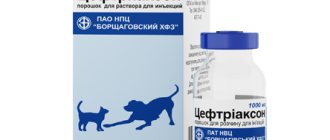What will you learn from the article?
- Causes of gastritis in cats
- Forms of gastritis in cats
- Symptoms of gastritis in cats How does chronic gastritis manifest in cats?
- What to feed a cat with gastritis
Gastritis in cats is an inflammation of the stomach lining. Our smaller brothers, like people, are susceptible to this disease. But, unlike us, cats cannot complain of stomach pain, so it is very important to recognize gastritis in a pet in the initial stages in order to prevent complications of the disease.
Gastritis can be acute or chronic. Most often, adult cats get sick, but due to improper feeding, the disease can also develop in kittens.
Read about the ranking of the best wet and dry food in 2015.
Description and types of gastritis
Clinically, disturbances in the gastrointestinal tract are expressed by indigestion. Usually the condition improves quickly after symptomatic therapy. But treating the symptoms of gastritis in a cat is always a half-measure. It is important to identify and eliminate the factor provoking the exacerbation and the cause of the disease, if any.
There are acute and chronic gastritis. Acute attacks may be the result of a single exposure of the pathogen to the gastric mucosa or indicate a worsening of a chronic condition.
Based on the nature of the damage, there are 4 main types of acute gastritis in cats:
| Type | Probable Causes | Damage |
| Catarrhal | Food poisoning, unhealthy diet, pathogenic bacteria | Superficial inflammation, swollen mucosa, bleeding |
| Fibrinous | Poisoning with acids, mercury-containing drugs, severe infections | Affects deep layers |
| Corrosive | Ingestion of phosphates, saltpeter, chlorine, alkalis (poisons, chemicals, fertilizers) | Necrosis |
| Phlegmonous | Complications and injuries due to surgery, infection, ulcers, cancer | Purulent inflammation |
Common types of chronic gastritis in cats: A or autoimmune occurs with the formation of antibodies, the culprit of gastritis B is the Helicobacter bacterium, type C is a consequence of the backflow of the contents of the duodenum into the stomach (reflux).
Causes and types
Before treating gastritis, material is taken from the cat to determine acidity. With increased secretory function, excess juice remains in the stomach for a long time, corroding its walls. Low acidity slows down digestion - food rots, releasing toxins and increasing the number of pathogenic bacteria.
About 30% of diseases are caused by internal factors:
- effects on the stomach of other organs;
- hormonal and metabolic disorders;
- Sinusitis
Hyperparathyroidism
Epilepsy
genetic predisposition;
- chronic infections;
- diseases of the endocrine system.
In other cases of gastritis in cats, external factors are to blame:
- unbalanced diet, sudden menu changes;
- bones, fatty fish and meat, table food;
- cheap industrial feed;
- lack of feeding regimen, dirty water;
- greedy swallowing of food;
- hot or cold food;
- medicines, poisons, chemicals;
- infections, parasites;
- ingestion of fur;
- chronic stress.
Most often, the doctor diagnoses banal (simple) gastritis. In cats, symptomatic treatment usually quickly produces positive results. It is more difficult when the disease is caused by a specific effect on the mucous membrane. For example, hypoxemic gastritis occurs against the background of oxygen starvation (lung, heart, vascular disease).
Disturbances in the genitourinary system cause uremic gastritis in cats. The mucous membrane reacts with inflammation to increased levels of urea in the blood. Due to a prolonged allergic reaction, eosinophilic gastritis develops. In cats, it is an autoimmune disease that is difficult to treat.
Hypoallergenic diet for cat gastritis
In some cases, feline gastritis is caused by the ingestion of a large number of antigens. If an animal often exhibits allergic reactions, is infected with worms and consumes food with a large number of artificial additives, then it may develop so-called eosinophilic gastritis, in which the gastric mucosa is attacked by its own immune cells.
In this case, the cat will be shown hypoallergenic feeding. Unfortunately, even the highest quality medicinal hypoallergenic foods rarely lead to the desired result: they contain too many components, each of which can be an allergen.
The solution may be a natural monoprotein diet, the idea of which is to eat food for 4-6 weeks with 1 source of protein and 1 source of carbohydrates that have not previously been offered to the cat. Examples of such products include low-fat cottage cheese, lamb or duck meat as sources of protein, plus green peas as a source of carbohydrates and fiber.
Prescribing a therapeutic diet for cat gastritis is recommended only after a thorough examination of the animal and an accurate diagnosis. Only correctly identifying the cause of inflammation, the type and degree of damage to the organ, as well as a review of the existing diet will help achieve lasting results in the treatment of the disease.
Symptoms
It is quite difficult to notice a chronic course. The owner mistakes the refusal of food for a whim or a normal digestive disorder. Vomiting once - he probably ate something wrong or there was a build-up of fur. Implicit symptoms of gastritis in a cat increase during periods of exacerbation:
- appetite decreases or disappears;
- vomiting until the stomach is cleared, sometimes with foam and/or blood;
- diarrhea or constipation progressing to diarrhea, possibly blood and pieces of food;
- flatulence, gases acquire a strong foul odor;
- thirst due to dehydration due to vomiting, diarrhea;
- painful, tense stomach, rumbling intestines, stiff posture;
- belching, sour or putrid odor from the mouth;
- coated tongue - yellowish or gray coating, especially at the root;
- the mucous membranes of the oral cavity are pale or yellowish;
- lethargy, possible aggression due to pain when trying to pick up the pet, unkempt fur.
Often, in the chronic form, attacks of gastritis in cats go away without treatment - a single vomiting and short fasting is enough to relieve inflammation. It is important to understand that this is a relief of symptoms - the disease has not disappeared, a visit to the clinic is still necessary.
An acute attack can be accompanied by severe pain - the cat cannot find a place for itself, screams, or vice versa, hides in a far corner, calms down in one position, breathing with its mouth open. Body temperature rises by a degree - a drop below normal indicates an increase in general weakness and possible internal bleeding. This is an emergency.
Diagnostics
It will not be difficult for an experienced veterinarian to understand from the symptoms that the cat has gastritis - an examination and anamnesis are enough for a primary diagnosis. But identifying the cause requires a thorough examination. First of all, gastric juice is analyzed for quantity, total acidity and hydrochloric acid content.
General and biochemical blood tests allow us to judge the state of the body as a whole and the functioning of individual systems. Urine biochemistry is necessary to exclude urolithiasis and chronic renal failure. The level of pepsinogen in the blood indirectly indicates the condition of the gastric mucosa. The coprogram will allow you to evaluate the enzymatic, digestive, and evacuation functions of the gastrointestinal tract.
In all cases, endoscopy is indicated - an informative method that allows you to visually assess the condition of the mucous membrane. Unfortunately, even a banal gastroscopy is not available in all clinics and is performed only under general anesthesia. Endoscopy is necessary if the doctor suspects oncology - there is no other way to perform a biopsy.
To exclude the presence of foreign objects in the stomach, an x-ray is performed. It makes sense to do an ultrasound of the stomach only with new technology. Old devices and most portable models do not allow assessing the condition of hollow organs.
Development mechanism
There are two options involved. The first is when a hungry cat begins to secrete gastric juice (hydrochloric acid) at the sight of food. If the situation is repeated frequently, it provokes inflammation of the gastric mucosa.
In the second case, the disease develops in a well-fed pet when the breeder overfeeds it. Less gastric juice is secreted, the food remains stale, which is fraught with the development of inflammation of the mucous membrane and putrefactive processes.
A separate issue is uremic gastritis, which develops against the background of impaired renal function. More often, with nephritis, ICD, the excretory system begins to work incorrectly, and urea levels in the blood increase. It is this substance that is released through the gastric mucosa, the secretory and motor functions are disrupted, and inflammation develops.
Treatment
Before treating a cat’s gastritis on your own, it is important to weigh the risks. In the event of an acute attack, medical assistance should be provided immediately. Moderate symptoms can be removed so that the pet does not suffer before going to the clinic: stop feeding, take a teaspoon of Enterosgel or 3 ml of Phosphalugel from a syringe without a needle. Stop drinking if water provokes vomiting.
The main treatment is aimed at eliminating the cause - an individual approach in each case. If bleeding is severe, surgery may be necessary. General symptoms are eliminated comprehensively, depending on the situation:
- antiemetics Zofran, Cerucal
- increased acidity Omeprazole, Famotidine
- before feeding Almagel, Phosphalugel
- adsorbents Enterosgel, Smecta
- antispasmodics for pain
- saline or Ringer's for dehydration
- enemas to relieve inflammation, intoxication
Apart from adsorbents that work locally, it is advisable to abandon tablets in favor of injections and/or droppers - many medications irritate the already inflamed mucous membrane. In cases of uncomplicated severe chronicity, treatment of gastritis in cats gives positive results after a few days. But without the right diet, relapses are inevitable.
What can you feed?
When treating gastritis, great attention should be paid to diet. A lot depends on how exactly it will be observed. So, what can you give a cat with gastritis?
In the first day after an exacerbation, the purr should not be fed at all, but the cat should drink plenty. The next day in the morning you can give the cat some light food (a third or half of its usual portion).
Oatmeal or rice mucous porridge without salt, oil and, of course, spices is suitable as such food. In this case, the temperature of the feed should be only slightly more than room temperature. If there was no vomiting or diarrhea, then in the evening you can give her the same amount of the same food. Then the portions are gradually increased to normal.
What foods can be given to your pet depends on whether it has high or low acidity.
Increased:
- Dairy products.
- Slimy soups and cereals.
- Lean boiled meat.
- Low-fat fish varieties.
Reduced:
- One-day sour milk.
- Meat and fish soups.
- Properly boiled porridge in water.
- Eggs.
If your cat eats ready-made food, then you need to choose a diet for animals with sensitive digestion.
Attention!
It is necessary to replace the main source of protein in food. So, if the cat previously ate food based on rabbit meat, then it should be replaced with food containing lamb, turkey, or fish-based food.
Diet and prevention
The role of diet in the treatment of gastritis cannot be overestimated - many veterinarians consider it the most important condition for recovery. With chronic gastritis, the cat is on a special menu for life. Once a year, it is advisable to donate blood biochemistry to monitor the balance of nutrients.
Diet therapy
The doctor will help you choose a medicinal food, which, after the condition improves, is replaced with a preventive one. Eukanuba, Royal Canin, Hill's, and Pro Plan have such lines. Feeding with natural products is subject to a number of strict principles:
- food slightly above room temperature;
- completely exclude bones, skin, veins, cartilage;
- consistency – puree, soufflé, mashed, finely chopped;
- Meat and fish are boiled, stewed - they cannot be eaten raw;
- feeding in fractional small portions 5 times a day;
- If a doctor prescribes mineral water, the gas is first removed from it.
The first day of an acute attack, fasting is indicated, followed by careful feeding in small (literally spoon) portions and monitoring the condition. Canned Gastro Intestinal or boiled breast chopped into pate are suitable. Dry food is steamed with warm water and pounded into porridge.
If all is well, permitted foods are gradually added to the menu - vegetable puree, light cottage cheese, quail eggs, slimy oatmeal and rice porridge. Lean meat is mixed with them - lamb, poultry, veal, rabbit. White sea fish, lean, only clean fillets - cod, hake, pollock. Rough food provokes an exacerbation.
Exclude sausages, fatty, fried and salty foods, and any spices. With low acidity, today's cottage cheese and kefir help; with increased acidity, you can sometimes pamper your cat with liver, hearts, and beef tongue. To reduce pH, add carrot juice to meat or porridge.
How to help at home?
Sometimes it happens that for some reason the owner does not have the opportunity to immediately contact a veterinarian. What to do in this case and how to help your pet?
If gastritis has just begun to manifest itself with one symptom or a number of them, then first you can do the following:
- Switch your cat to a healthy diet. Ideally, use ready-made factory feed of at least premium class. If the cat eats regular food, then it is necessary to remove table food from its diet (it is almost certainly flavored with spices that are harmful to animals and over-salted), bones, bread, pasta and other foods harmful to purrs. You can leave lean meats and dairy products, while feeding them in small portions, but often. In addition, it would be advisable to offer your pet cat grass.
- To replenish the loss of fluid in the body, you can give your cat either saline or Ringer's solution, purchased at a regular human pharmacy. Ideally, it would be to give her a solution of Regidron (dilute 1 sachet of powder according to the instructions in 1 liter of water). You can drink all this either through a syringe, or, if the cat does not refuse to drink them, as a regular drink.
- If your pet is constipated, he may need a mild laxative. So, if ingestion of a foreign body is completely excluded, you can give your cat Duphalac at the rate of 2 ml per day for an average-sized adult animal. For kittens and large breed cats, this dosage should be adjusted based on the pet's weight.
Attention!
No medications, including antispasmodics, should be given to cats without a veterinarian's prescription. And, if the measures taken turned out to be useless, it is necessary to quickly take the animal to the doctor, and not engage in subsequent self-medication.











